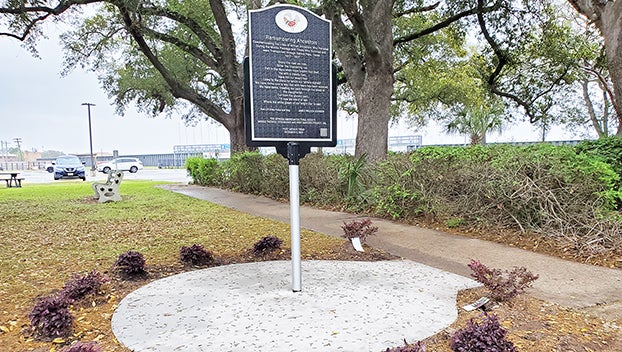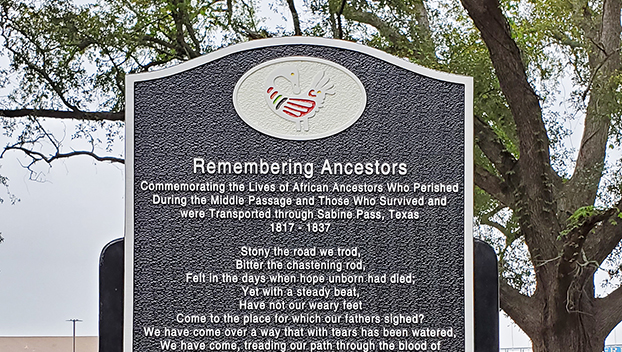Middle Passage Marker in Port Arthur commemorates ancestors, provides history of local slave trade
Published 12:08 am Tuesday, March 26, 2024

- The Middle Passage Marker was unveiled Saturday on Waco Avenue across from the side entrance to the Jefferson County Sub-courthouse. (Mary Meaux/The News)
|
Getting your Trinity Audio player ready...
|
For Port Arthur’s Gail Pellum, the newly unveiled Middle Passage Marker signifies healing and a time to reflect.
“It’s important to know where you come from and what you’ve been through,” said Pellum, president of the African American Cultural Society. “The marker is sad for some but gives purpose and direction.”
The marker notes — “Remembering Ancestors, commemorating the lives of African ancestors who perished during the Middle Passage and those who survived and were transported through Sabine Pass, Texas 1817-1837.”
The Middle Passage was the shipping route across the Atlantic Ocean that brought enslaved individuals from Africa to the United States. Historical research showed instances when enslaved individuals were brought through Sabine Pass.
Locals gathered Saturday at Popeye Holmes Park to note the unveiling of the marker, which is located on Waco Avenue across from the side entrance to the Jefferson County Sub-courthouse.
The event was brought on by the African American Cultural Society, in collaboration with the Middle Passage Ceremonies and Port Markers Project.
Pellum spoke of healing that is needed, not just here but worldwide.
Some don’t want to talk about the past and would just rather let the issue go, according o Pellum.
“You can’t let it go,” she said. “If you don’t learn from it, you will repeat it and it will not be good on either side.”
Part of healing is identifying what happened.
“You can’t ignore the past, you have to build off of it,” she said. “My biggest prayer is to let there be light and healing for the world. Light and healing for the world.”
The Middle Passage Marker features a selection from the song “Lift Every Voice and Sing” by James Weldon Johnson.
Pellum
Pellum remembers hearing stories from the older generation of family members who were enslaved. These stories, passed down, helped shape her into who she is today, fostering a passion for culture and work with local Juneteenth celebrations.
“My mother, there were 12 of us, she used to read to us, narratives. It touched my heart. It touched my soul. I’ve spent my whole life finding creative ways to tell the story through art and poetry and more,” Pellum said previously.
Pellum is an artist and celebrates the achievements of those who came before her.
“I am my ancestors’ wildest dream,” she said.
Middle Passage
The Middle Passage Ceremonies and Port Markers Project Inc. is a nonprofit established in 2011 to honor the 2 million captive Africans who died during the transatlantic crossing known as the Middle Passage, as well as the 10 million who survived and built the Americas, according to middlepassageproject.org.
The marker features a QR code that provides information on the history of the slave trade as it relates to the area.
The Sabine Lake and river was a neutral zone as part of an international boundary between the U.S. and Spanish Texas in the 1800s, but smuggling was still occurring.
There are historical accounts of enslaved individuals being brought to and through the area:
- Approximately 40 Africans landed at Caney Creek below Velasco after plantation owner Sterling McNeel evaded customs officers. Several months later, McNeel and his brothers ferried a group of them across the Neches River, west of the Sabine.
- Enslaved people arrived aboard English vessel Elizabeth, which Captain John Taylor of Barbados docked at a marshy point of Sabine Pass known as Brig landing. Taylor transported approximately 50 of the chattels by yawl boat to Joseph Grigsby’s plantation at Port Neches before taking them overland to San Augustine. Taylor then returned to Sabine Pass with the captives he failed to sell before heading to Galveston Bay.
- Approximately 200 Africans from Cuba arrived somewhere on the Sabine River aboard a vessel commanded by a Spaniard named Moro and owned by an American known as Coigly. Their fate remains unknown.
According to the historical data, the last documented arrival in the Sabine region occurred in 1837, when a British vessel chased a ship with African captives through Sabine Pass until it ran aground on a mud flat in Sabine Lake at Blue Buck Point though ships continued to land along the Texas coast during the Civil War.



